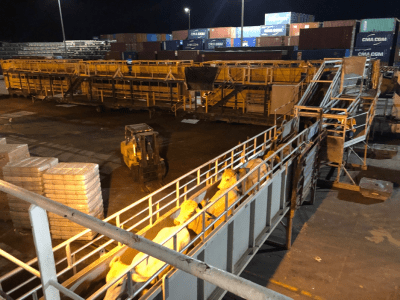Prices for slaughter weight steers to Vietnam have spiked by 50c/kg in a few short weeks, with a confluence of two key factors said to be behind the surge.
Five cattle exporters competing directly to fill four ships within three weeks out of one port – Townsville – was one major factor behind the rise, according to trade sources.
Contributing simultaneously to the upward pressure on prices has been the ongoing presence of southern processors from Victoria and New South Wales competing for slaughter stock in Queensland.
Northern processors have raised their over-the-hooks prices for slaughter stock in response to the southern competition. (See more on this in Beef Central’s Weekly Kill report from earlier this week).
The arrival of a series of export ships which were booked to load in Townsville in a tight July to mid-August window brought five large export orders into the market at the same time.
A recent slow-down in export activity to Indonesia, a lack of demand for shipments to the comparatively lifeless China market and the mid-year prohibition on sheep exports to the Middle East for the Northern Hemisphere summer meant several ships effectively became available at the same time.
Elders Northern Queensland/NT State Livestock Manager Scott Mawn told Beef Central that the demand created by the convergence of several live export boats combined with southern processors in the market had driven a significant price increase from 265c/kg to as high as 315c/kg in a period of three weeks.
Exporter Tony Gooden from Frontier International Agri described it as “a perfect storm” with several orders culminating in a short period of time after a rain event and along side sharp price rises driven by competition between northern and southern processors.
Vietnam is regarded as a price sensitive market and the higher price levels are unlikely to be sustained beyond the current demand period.
The sharp increase had pushed prices higher than Vietnamese importers would be prepared to pay going forward, underpinning expectations of limited trade activity to Vietnam at current price levels following this latest round of shipments.
Despite this Scott Mawn said the overall demand picture was looking positive.
 “There is a demand for those slaughter cattle and the feeder job kicked again this week,” he said.
“There is a demand for those slaughter cattle and the feeder job kicked again this week,” he said.
“I think there is plenty of upside, particularly when you look at where we have been on the eastern seaboard for the first two thirds of the year, the back end (of the year) seems to be picking up a bit of momentum.”
Balanced against that was the annual decline in pasture conditions across northern Australia through August and September.
“We’re getting into that time of year where cattle will start to go backwards it is purely driven by a protein drought, historically we see cattle start to flatline and then start to slip a little bit going into this back end of the year until the next wet season.”



This is why it is crucial that the tropical beef genetics in this country are maintained. The live export industry is the only real competition we have in the beef industry to maintain any kind of floor price for our product effective direct from the paddock. The current feedlot/processor discounts for bos indicus genetics which underpin the live export market are achieving an outcome of live export cattle being “bred out”. Previous to live export, being a cattle producer in Australia was a very ordinary business most years. In retrospect the industry has been a good one since it’s inception. Be very careful in going backwards to bos-taurus genetics in the environments which do not suit them. They can be very cost intensive to maintain. When they become the status quo once again live export from here may be replaced by Indian buffalo beef and we will once again be in a very precarious place for the long haul. Been there and done that on all counts, genetics and price for product. A complete independant 10 year financial analysis of all aspects of changing from the well credentialed trials of tropical breeds versus bos-taurus breeds is essential to see just how much discount we can cop from the processing industry short term in comparison to the long term pain we may suffer.
Wait till albo bans it there will be no money in it then